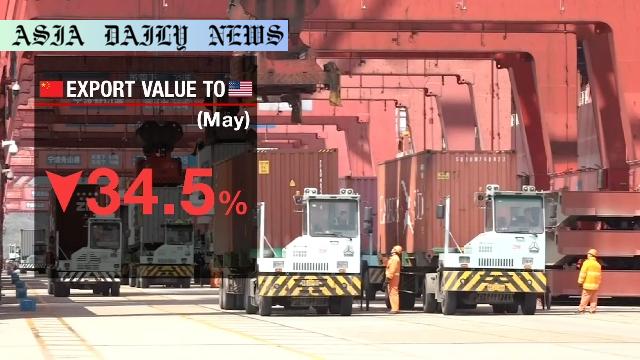China’s exports – China’s exports to the US tumbled in May amid tit-for-tat import tariffs imposed by both nations.
- China’s exports to the US dropped by 34.5% in May year-over-year.
- Imports from the US to China also declined by 18.1%.
- Trade tariffs of over 100% were imposed in April, escalating the tension.
- May saw a partial de-escalation as both nations committed to talks and tariff reductions.

China’s Exports to the US Take a Significant Plunge
In an era where global trade dynamics are continuously evolving, the latest statistics reveal a sharp downturn in China’s export relationship with the United States. In May, China experienced a staggering 34.5% year-over-year drop in exports to the US, underscoring the detrimental impact of the ongoing trade war. Chinese customs data indicates that this marked decline is directly tied to heightened tariffs imposed by both nations as part of their retaliatory trade strategies. With imports from the US to China also seeing an 18.1% reduction, it’s clear that both countries are feeling the strain of trade discord.
Understanding the Role of Tariffs in the Decline
These daunting figures reflect the aftermath of more than a year of escalating tariffs between the world’s two largest economies. By April, both countries had imposed tariffs exceeding 100% on various goods, creating substantial barriers to trade. These tariffs not only disrupted supply chains but also raised costs for businesses and consumers alike. The resulting economic frictions, combined with a global slowdown caused by other economic pressures, have contributed to the decreased trading activity showcased in the May statistics.
Signs of Optimism: Reduced Tariffs and Renewed Talks
Despite the grim export figures, recent developments may provide a glimmer of hope for improved relations. In May, both nations agreed to ease some of the tariffs and initiate constructive dialogue. These steps mark a significant shift in the trajectory of the trade conflict. The upcoming negotiations in London—where China’s Vice Premier He Lifeng and US Treasury Secretary Scott Bessent will meet—are expected to delve deeper into solutions that could address these economic fissures. If successful, such talks could pave the way for a renewed era of trade cooperation.
The Broader Implications of the US-China Trade War
The consequences of the US-China trade war extend beyond these two nations. As major players in the global economy, any significant disruption in their trade has far-reaching implications. Businesses that rely on Sino-American supply chains face uncertainties, while global markets watch closely for signs of recovery or further deterioration. For the global trade ecosystem to stabilize, it is imperative that both nations find a way to resolve their economic differences and set an example for managing international trade disputes constructively.
Path Forward: A Lesson in Global Collaboration
The significant drop in trade between China and the US serves as a stark reminder of the interconnectedness of today’s economies. As negotiations progress, stakeholders worldwide are hopeful that these economic superpowers will prioritize collaboration over confrontation. A trade agreement that benefits both nations and encourages sustainable trade practices could set a precedent for resolving future disputes. In an increasingly multipolar world, such a resolution is not just desirable—it’s essential.



Commentary
Reflecting on the Significance of the Trade Decline
The reported 34.5% plunge in China’s exports to the United States is certainly dramatic and serves as a wake-up call to policymakers and businesses alike. Such a sharp decline underscores just how impactful trade policies can be on the health of international commerce. Beyond the numbers lies a deeper narrative about the fragility of the global trade system and the unintended consequences of prolonged economic tension between superpowers. This downturn directly affects businesses, employees, and consumers, further highlighting the ripple effects of such economic conflicts.
Hope for Resolutions amidst Rising Challenges
It is heartening to observe some signs of progress as both nations move towards reduced tariffs and meaningful negotiations. However, these discussions are just the beginning of a long road to economic stability. Trade negotiations rarely provide immediate results, and the healing process for disrupted industries can take even longer. Still, the willingness of leadership in both countries to return to the table signals a shared understanding that collaboration is in everyone’s best interest, especially during a time when global economic vulnerabilities have been exacerbated by other crises, such as post-pandemic recoveries or geopolitical instabilities.
The Importance of Building Resilient Trade Relations
As the details continue to emerge from these trade talks, the global community has much to observe and learn. Trade wars, while serving as a display of economic strength, ultimately hurt all parties involved. Rather than engaging in retaliatory practices, the focus should be on building frameworks that balance economic competition with mutual benefit. Such strategies could not only prevent future trade disruptions but also foster a global environment of trust and cooperation that benefits everyone.